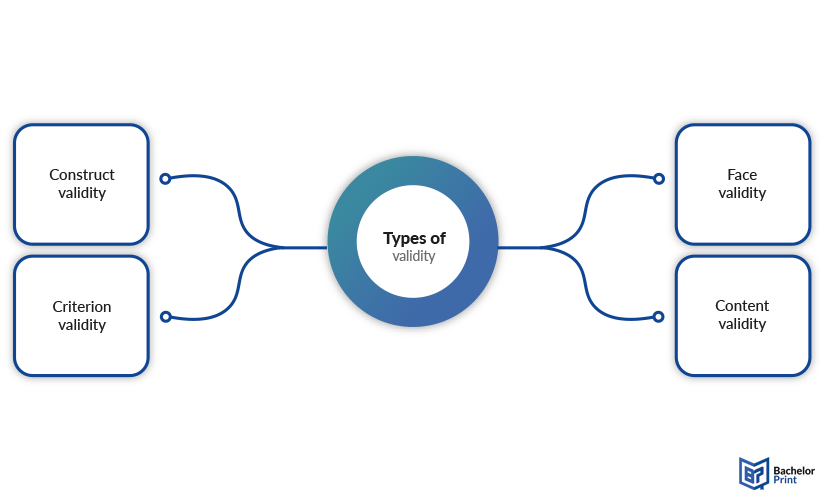
Validity is a crucial concept that is connected to the methodology that guides any research process. It influences how well a study’s design and tools address the research question at hand. It ensures that conclusions drawn from data are meaningful and reliable. In this article, we’ll explore what validity means, why it matters, and the different types to help university students avoid confusion.
Definition: Validity
Validity is the degree to which a study or research method accurately reflects the claims it measures. It’s not enough to simply collect data, validity ensures that the methods capture real-world situations effectively, without being biased or influenced by other factors. A valid approach produces results that genuinely correspond to the concept under study so that any conclusions drawn from the data are both trustworthy and relevant.
Types
There are four types of validity: construct validity, content validity, face validity, and criterion validity. While construct validity is considered the most important type, the four main types can be further broken down into five subtypes within: predictive, concurrent, postdictive, discriminant, and convergent.
Construct validity refers to how well a method measures the theoretical concept — or construct — it is intended to assess. A construct is an abstract idea, such as ageism, poverty, or financial performance, that may involve behaviors or characteristics. Some constructs in quantitative research (like age or height) can be observed directly, while others (like depression or disability) must be inferred from related indicators. Those indicators are monitored and analysed to produce meaningful research results. To demonstrate construct validity, researchers often examine:
- Convergent validity: The measure correlates strong with other valid measures of the same construct.
- Discriminant validity: The measure does not fully correlate with measures of unrelated constructs.
Content validity refers to how completely a method covers all facets of the concepts it’s intended to measure. To achieve content validity, a test must include every essential component of the construct. So, if it omits an important aspect, the results cannot be considered fully valid.
This type refers to the extent to which a test, on a surface-level, appears to measure what it’s supposed to measure. Unlike more technical forms, face validity is subjective, meaning it depends on whether people believe that the assessment “looks like” it covers the intended construct. If a measure lacks face validity, individuals may distrust its results or refuse to take it seriously, even if it is valid.
Criterion validity assesses how well a test’s scores correspond with a valid, external standard (criterion) known to reflect the same construct. There are three subtypes:
- Concurrent validity: The new study and the criterion are measured at the same time.
- Predictive validity: The new study is given first, and the criterion outcome is measured later.
- Postdictive validity: The new study is compared against a past outcome.
If the new measure correlates highly with the established criterion, it has strong criterion validity; otherwise, its scores can’t be trusted to reflect real-world performance.
In short:
| Construct | Measures if a test truly reflects existing theoretical construct it targets. |
| Content | Measures if the test items collectively cover all facets of the concept. |
| Face | Measures if, on the surface, the test appears to measure what it claims to. |
| Criterion | Measures how closely the results correspond with an external standard for the same construct. |

Common threats
Below, we focused on common threats to internal and external validity in research.
Internal validity
Internal validity refers to whether the observed changes in your dependent variable can truly be attributed to the independent variable and not some other factors.
- History: Events unrelated to the study occur during the experiment and influence the results. For example, a natural disaster or policy change could affect participants’ behaviour devoid of the treatment.
- Maturation: Participants naturally change over time due to growth or learning. These changes might be mistaken for treatment effects if not controlled.
- Testing effects: Repeated testing can affect participants’ responses through practice or familiarity. This may cause improvements unrelated to the intervention itself.
- Instrumentation: Inconsistencies in measurement tools or observers can lead to differences in outcomes. For instance, a new tester might score participants differently than the original one.
- Selection bias: Differences in participant characteristics between groups at the start can influence results. If groups aren’t comparable, it’s unclear if outcomes stem from treatment or initial differences.
- Attrition bias: Participants dropping out of the study unevenly across groups can bias findings. If those who leave differ systematically, the remaining sample no longer represents the original population.
External validity
External validity concerns whether your findings can generalize to other populations or settings.
- Population validity: When the study sample is not representative of the larger population, results may not generalize. For example, findings from university students may not apply to older adults.
- Ecological validity: Research conditions differ from real-world settings. A lab experiment might not reflect how people behave in natural environments.
- Temporal validity: Findings may only apply to the specific time when the study was conducted. Changes over time, like cultural shifts or new technologies, can affect relevance.
- Interaction effects: The effect may depend on the participants or setting. For example, an intervention might work well in one school but fail in another with different resources or demographics.
How to ensure validity in your research
As a researcher, you can achieve this by selecting a research method that can answer your questions as accurately as possible, setting straightforward questions that nasty the same thing regardless of the person reading it, eliminating any biases. For example, by avoiding leading participants, and using sample size and sample type that is appropriate for the research.
FAQs
The four main types are: construct, content, face, and criterion.
A maths teacher creates a new quiz to assess students’ multiplication skills. If the quiz looks like it tests multiplications both students and teachers will agree it has strong face validity, meaning it appears to measure what it claims to measure at face value.
Common threats to validity include:
- Internal threats like history (external events affecting results), maturation (natural participant changes), testing effects (practice influencing scores), instrumentation changes, selection bias, and attrition (dropouts).
- External threats such as population validity (non-representative samples), ecological validity (study settings differing from real life), temporal validity (findings limited to specific times), and interaction effects (treatment working differently across groups or settings).
It is a condition used to determine if the results obtained after an experiment or research closely relate to real-world values. So, it helps researchers know if they obtained results or measurements that can be used to answer research questions and eliminates the factor of untrustworthiness of work done and results obtained.
